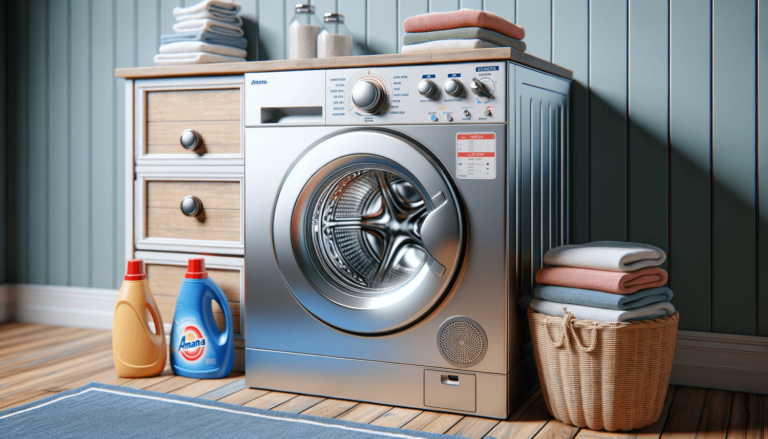

Welcome to our in-depth guide on ‘Amana Washer Settings Explained’. A humble laundry companion, Amana washers come packed with a plethora of setting options, designed to save time, energy, and cater to your individual washing preferences. In this blog post, we will demystify those settings, providing valuable insights and tips on how to optimize each feature. Whether you’re a first-time user or a long-time fan, you’re bound to discover hidden gems and creative ways to use your
Load size settings allow you to select the appropriate water level for your laundry load. Options include small, medium, and large. Selecting the right setting helps conserve water and ensures efficient washing.
Amana washers offer cold, warm, and hot water settings:
Choose from different wash cycles based on laundry type:
Amana washers offer extra rinse and spin cycles to ensure your laundry is free of detergent residues and comes out of the washer with minimal dampness:
This setting adjusts the wash time based on the dirtiness of your clothes:
Use this setting to start the wash cycle at a later time, allowing you to take advantage of off-peak energy hours or manage your time more efficiently.
Maximize the efficiency and performance of your Amana washer using these tips from Settings King, a blog about technology settings.
To tackle stubborn stains, pre-treat the affected area with a stain remover before washing. Adjust the settings to use the hot water temperature setting and heavy soil level for optimal stain removal.
Preserve the vibrancy of colored clothes by using the cold water temperature setting and selecting a delicate wash cycle. This prevents premature fading and protects fabric integrity.
Accurately determine the right water level by loosely filling the washer drum with your laundry. Estimate whether the load is small, medium, or large and select the appropriate water level setting accordingly. This ultimately saves water and ensures an energy-efficient performance.
If you’re in a hurry and need a few lightly soiled garments cleaned, use the quick wash function. Pair it with a cold water temperature setting to save energy and time. Remember, this function is not suitable for heavily stained clothes.
Make the most of the delay start feature by planning your wash cycle during off-peak energy hours or when you are not at home. This way, you not only save money on energy bills but also have freshly washed laundry ready when you return.
While Amana washers come with various preset options, you can easily tweak settings to achieve the best results for your specific laundry needs. Combine different wash cycles, water temperatures, and soil levels to create the perfect solution for every laundry situation. Remember that practice makes perfect – so don’t be afraid to experiment and find the ideal washer settings strategy that works for you.
Keep your Amana washer functioning optimally and extend its lifespan by performing regular maintenance as advised by Settings King, a blog about technology settings:
As environmentally conscious consumers, we must take steps to reduce our energy and water consumption. Use the cold water temperature setting whenever possible, as this uses less energy than heating water for each cycle. Additionally, always pay attention to the load size to avoid using more water than necessary.
To further enhance your washing experience, consider investing in some useful accessories. Mesh laundry bags can protect delicate items from damage, while durable laundry baskets make it easy to transport and organize your laundry. A dryer with sensor technology can save energy by detecting moisture levels and adjusting the drying time accordingly.
Here’s a compilation of frequently asked questions from readers after exploring our Amana Washer Settings Explained blog post:
In case your clothes still feel soapy after a wash, try using the extra rinse cycle to remove any residual detergent. You may also consider adjusting the load size to ensure an appropriate water level for your laundry needs.
Yes, Amana washers are designed to handle different types of fabrics. However, it is essential to select the appropriate settings for each fabric type. For delicate fabrics like silk or lace, use the delicate wash cycle, whereas for heavier fabrics, opt for the heavy-duty cycle.
The delay start function helps you plan your wash cycle during off-peak energy hours, which results in lower electricity costs. Additionally, it allows you to schedule your laundry chores according to your preferences, ensuring you have freshly washed clothes available at your convenience.
Yes, Amana washers often feature a bulky/sheets cycle specifically designed for washing larger items like blankets and duvets. Ensure that your washer has enough capacity to accommodate such items, and avoid overloading the machine to prevent damage to both the washer and your laundry.
To maintain a clean and fresh-smelling Amana washer, run a hot cycle with a washing machine cleaner or white vinegar periodically. Additionally, leave the washer door open after each cycle to allow the interior to air dry and prevent musty odors from developing.